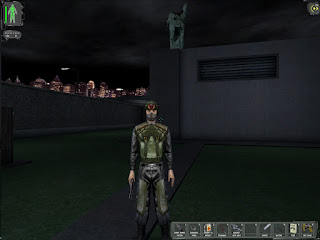[UPDATE: August 17, 2014: Here's a more updated guide: YouTube: Deus Ex One Mod Tweak Guide How to Improve Graphics with Better Textures
You should still read the guide below as it contains some parameters you might want to tweak.]
[UPDATED: August 16, 2011]
[UPDATE: The Deus Ex: New Vision graphics mod has been released. The link below includes this updated version.]
So I just installed Deus Ex in the hopes that I can finish both Deus Ex: Game of the Year Edition and Deus Ex: Invisible War before Deus Ex: Human Revolution hits the shelves. This PC first-person shooter's graphics, is, of course, sub-par with today's standards so I hunted around for Deus Ex 1 graphics mod packs.
I found this:
Znokiss' Ultimage Tutorial (Graphic and texture mods for the Steam version of Deus-Ex)
[Warning: The preceding link takes you away from this site. Furthermore, the above Deus Ex texture graphics mod pack isn't mine. Install at your own risk.]
[Update: Some people have complained that the mod doesn't work. Installing the Visual C++ 2010 runtime fixes the problem.]
Before and after screenshots and my own tweaks to the PC texture mod after the jump.
The graphics bundle brings bloom and bump mapping to Deus Ex's obsolete engine but I think the gamma level is way too low. Also, the bump mapping and the saturation levels are overdone in my opinion:
BEFORE:



AFTER:



I'm going to find a way to tone down the shadows, bump mapping, and saturation. Otherwise, I'll have to play without the ENB mod. Some of its effects are just too jarring for me.
UPDATE:
Found the fix. According to Steam forum member SillyCon, you have to tweak several parameters in the enbseries.ini file. These are:
[EFFECT]
...
EnableReflection=1
...
EnableWater=1
EnableShadow=1
DepthBias=0
...
[COLORCORRECTION]
DarkeningAmountDay=10
ScreenLevelDay=60
ScreenLevelNight=20
DarkeningAmountNight=-10
...
GammaCurveNight=3
...
[SHADOW]
ShadowFadeStart=40
ShadowFadeEnd=80
ShadowAmountDay=60
ShadowAmountNight=30
ShadowScreenLevelDay=60
ShadowScreenLevelNight=20
...
FilterQuality=2
ShadowBlurRange=30
I also managed to find the parameters for the saturation and the bump mapping levels (which were too unrealistic for my tastes). These are:
[REFLECTION]
UseEnvBump=0
EnvBumpAmount=0
EnvBumpOffset=0
ReflectionFlip=0
[COLORCORRECTION]
ColorSaturationDay=-1
ColorSaturationNight=-1
The saturation parameters seem to only accept whole numbers so I settled for "1"s. A "-0.65" would have been more to my liking. A pity. (The higher the number the more saturated the colors become; setting "5"s results in a psychedelic show.)
I'll see tomorrow if I can solve the chrome effect. I find that shiny rock walls don't make for a good immersive experience.
>>>Click here to read more...

















